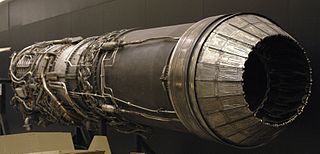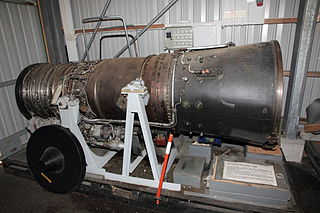
The Pratt & Whitney J57 is an axial-flow turbojet engine developed by Pratt & Whitney in the early 1950s. The J57 was the first 10,000 lbf (45 kN) thrust class engine in the United States. It is a two spool engine.

The General Electric J79 is an axial-flow turbojet engine built for use in a variety of fighter and bomber aircraft and a supersonic cruise missile. The J79 was produced by General Electric Aircraft Engines in the United States, and under license by several other companies worldwide. Among its major uses was the Lockheed F-104 Starfighter, Convair B-58 Hustler, McDonnell Douglas F-4 Phantom II, North American A-5 Vigilante and IAI Kfir.

The General Electric/Allison J35 was the United States Air Force's first axial-flow compressor jet engine. Originally developed by General Electric in parallel with the Whittle-based centrifugal-flow J33, the J35 was a fairly simple turbojet, consisting of an eleven-stage axial-flow compressor and a single-stage turbine. With the afterburner, which most models carried, it produced a thrust of 7,400 lbf (33 kN).

The Tumansky R-11 is a Soviet Cold War-era turbojet engine.

The Tumansky R-13 is a Soviet turbojet engine designed by Sergei Alekseevich Gavrilov.

The Tumansky R-25 is a turbojet engine, which is seen as the ultimate development of Tumansky R-11. It was designed under the leadership of Sergei Alekseevich Gavrilov.

The Lyulka AL-7 was a turbojet designed by Arkhip Mikhailovich Lyulka and produced by his Lyulka design bureau. The engine was produced between 1954 and 1970.

The Tumansky R-15 is an axial-flow, single-shaft turbojet with an afterburner. Its best known use is on the Mikoyan-Gurevich MiG-25.

The General Electric CJ805 is a jet engine which was developed by General Electric Aircraft Engines in the late 1950s. It was a civilian version of the J79 and differed only in detail. It was developed in two versions. The basic CJ805-3 was a turbojet and powered the Convair 880 airliner, and the CJ805-23 a turbofan derivative which powered the Convair 990 Coronado variant of the 880.

The Saturn AL-31 is a family of axial flow turbofan engines, developed by the Lyulka-Saturn design bureau in the Soviet Union, now NPO Saturn in Russia, originally as a 12.5-tonne powerplant for the Sukhoi Su-27 long range air superiority fighter. The AL-31 currently powers the Su-27 family of combat aircraft and some variants of the Chengdu J-10 multirole jet fighter. Assembly of the engine is also performed under license in India by HAL, for the Sukhoi Su-30MKI. Improved variants power the fifth-generation Sukhoi Su-57 and Chengdu J-20.

The General Electric YJ93 turbojet engine was designed as the powerplant for both the North American XB-70 Valkyrie bomber and the North American XF-108 Rapier interceptor. The YJ93 was a single-shaft axial-flow turbojet with a variable-stator compressor and a fully variable convergent/divergent exhaust nozzle. The maximum sea-level thrust was 28,800 lbf (128 kN).

The General Electric GE4 turbojet engine was designed in the late 1960s as the powerplant for the Boeing 2707 supersonic transport. The GE4 was a nine-stage, single-shaft, axial-flow turbojet based largely on the General Electric YJ93 which powered the North American XB-70 bomber. The GE4 was the most powerful engine of its era, producing 50,000 lbf (220 kN) dry, and 65,000 lbf (290 kN) with afterburner. The Boeing 2707 was cancelled in 1971, putting an end to further work on the GE4.

The General Electric J73 turbojet was developed by General Electric from the earlier J47 engine. Its original USAF designation was J47-21, but with innovative features including variable inlet guide vanes, double-shell combustor case, and 50% greater airflow was redesignated J73. Its only operational use was in the North American F-86H.
The Lyulka TR-1 was a turbojet designed by Arkhip Lyulka and produced by his Lyulka design bureau. It was the first indigenous Soviet jet engine.
The Lyulka TR-3 was a Soviet axial turbojet designed after World War II by Arkhip Mikhailovich Lyulka.

The Turbomeca Gabizo was a small turbojet engine produced by Turbomeca from the 1950s. The components were designed to take the stresses of high-speed fighter aircraft with some variants featuring afterburner.

The Tumansky R-29 is a Soviet turbojet aircraft engine that was developed in the early 1970s. It is generally described as being in the "third generation" of Soviet gas turbine engines which are characterized by high thrust-to-weight ratios and the use of turbine air cooling.
The Tumansky R-21 was a Soviet turbojet engine of the 1960s. Used for development only, the project was canceled.
The Daimler-Benz DB 007 was an early German jet engine design stemming from design work carried out by Karl Leist from 1939. This was a complex design featuring contra-rotating stages and a bypass fan, making it one of the earliest turbofan designs to be produced. The end result of the design work was built as the DB 007 and began testing on a test-bed on 27 May 1943. Due to the expected low performance, complexity and the good results achieved by much simpler designs, work was halted on the DB 007 in May 1944 by order of the RLM.

The Saturn AL-51, internal development designation izdeliye30, is an afterburning low-bypass turbofan engine being developed by NPO Saturn to succeed the Saturn AL-41F-1 for improved variants of the Sukhoi Su-57, as well as new potential tactical fighters such as the Sukhoi Su-75 Checkmate.
















